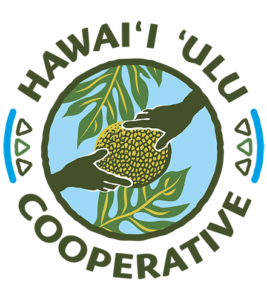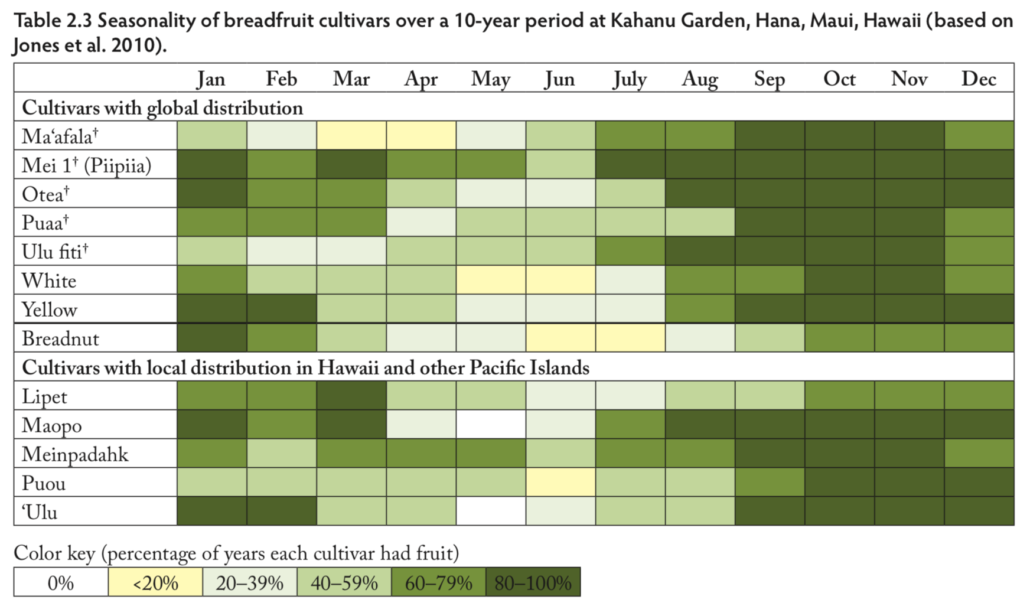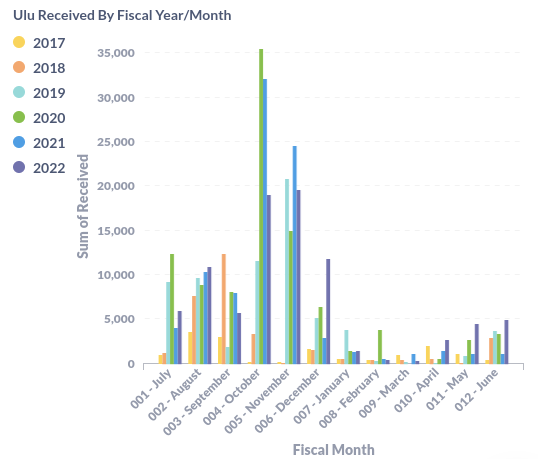ʻULU PRODUCTION PRIMER
Cultivars
According to the Breadfruit Agroforestry Guide by Ragone and Elevitch (2018), a study of more than 90 breadfruit cultivars reported fruit weights from 1.0–7.8 lb, averaging 3.5 lb. This is similar to Hawaiian ‘ulu or ‘ulu maoli, the variety first introduced to Hawai’i and prevalent throughout the islands. Fruit weighing nearly 11 lb have been harvested from the Micronesian cultivar ‘Lipet’.
The edible portion of breadfruit (skin and core removed) comes in at 60-65% — 80% with just the core removed. Most folks prefer larger fruit because of the lower skin/core to flesh ratio. Some folks buying fresh fruit prefer smaller fruit for smaller meals.
July-December is the prime yield window for most cultivars in Hawaiʻi.
You can plant multiple different cultivars to stagger yields across the season.
Source: Breadfruit Production Guide, 2nd Edition – Craig Elevitch, Diane Ragone, Ian Cole
Hawaiʻi ʻUlu Coop, Fruit Intake Data
Grafting & Nursery Stock:
Common methods of propagation in Hawai’i include tissue culture, air layering, adventitious cuttings, or vegetative root shoots.
The Ma’afala and Otea cultivars are currently available in Hawaii via tissue culture, and multiple labs are currently working on micropropagation with additional varieties.
Digging up and potting root shoots is an easy, affordable propagation technique; air layering and adventurous shoot cultivation are also relatively accessible methods for farmers and low-tech nurseries to produce trees.
See our Producer Educational Videos page to see several detailed examples of propagation techniques as well as our Propagation Guide PDF.
Propagation
It is possible to propagate trees using cuttings from shoots or roots. Propagation from seed is rare in breadfruit production on a commercial level.
Air-layering, seen below, has emerged as an effective way to produce clonal nursery stock from selected cultivars. A video example covering air layering basics can be seen HERE.
Fruit Size & Composition
According to the Breadfruit Agroforestry Guide by Ragone and Elevitch (2018), a study of more than 90 breadfruit cultivars reported fruit weights from 1.0–7.8 lb, averaging 3.5 lb. This is similar to Hawaiian ‘ulu or ‘ulu maoli, the variety first introduced to Hawai’i and prevalent throughout the islands. Fruit weighing nearly 11 lb have been harvested from the Micronesian cultivar ‘Lipet’.
The edible portion of breadfruit (skin and core removed) comes in at 60-65% — 80% with just the core removed. Most folks prefer larger fruit because of the lower skin/core to flesh ratio. Some folks buying fresh fruit prefer smaller fruit for smaller meals.
Yield
- Trees generally begin bearing fruit when four to seven years old, with most trees starting to fruit in years 5-6.
- The first year, sometimes two, of fruit production may be insignificant in volume or express excessive dimpling or fruit abortion – this is expected behavior during early maturation.
- On average, breadfruit trees produce 90% Grade A fruit and 10% Grade B fruit over the course of the season; however in certain years there is a greater amount of Grade B fruit due to environmental or management factors. See HUC’s Harvesting Guidelines for Fruit Grading details.
From the Literature:
- Although very high yields have been reported in the literature, in the order of 350–944 lb/yr of fruit among certain exceptionally productive trees (Elevitch and Ragone, 2018), current average production in Hawai’i is much lower.
In practice:
- Yields can vary drastically; however current data suggests that for trees planted in suitable habitat, receiving optimal management and being actively harvested, the following can be expected:
| Year | 1 | 2 | 3 | 4 | 5 | 6 | 7 | 8 | 9 | 10 | 11 |
|---|---|---|---|---|---|---|---|---|---|---|---|
| Yield (Lbs.) | 0 | 0 | 0 | 0 | 5 | 40 | 75 | 125 | 175 | 200 | 250 |
NEXT: Pests & Diseases


